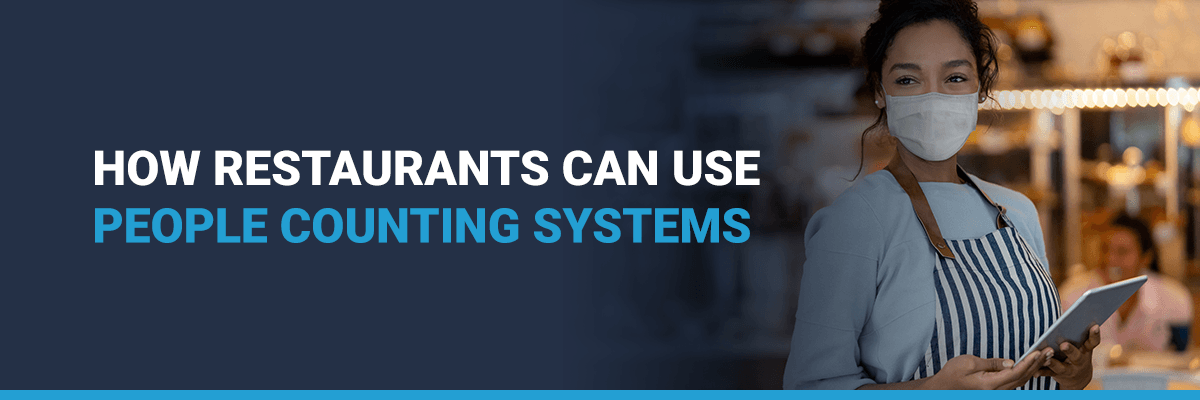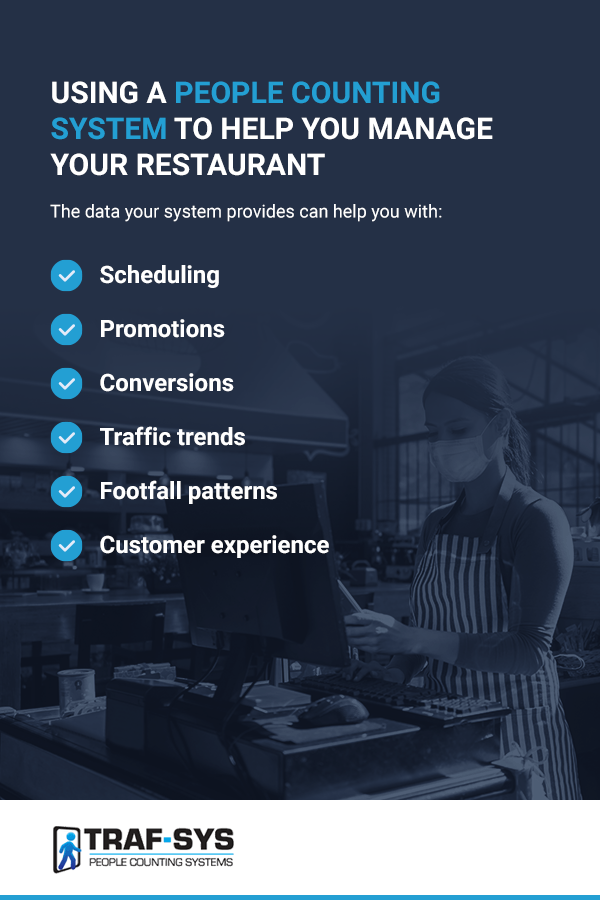

Table of Contents
Technology is on the menu for many restaurants looking for ways to improve their operations, enhance the customer experience and increase profits. One of the tech tools you may not have considered yet for your restaurant business is a people counting system. These systems are especially popular in the retail industry, but some restaurateurs are catching on to the fact that people counting systems also have some valuable applications in their sector.
These systems can help restaurant owners and managers monitor their occupancy levels for social distancing requirements and provide them with important metrics for managing and improving their businesses. If you’re interested in these major benefits, take a moment to learn more about people counting systems and how you can use them in your restaurant.
Read the full article or skip to a specific section:
Learn How Restaurants Can Benefit from People Counting


If you’re new to the world of people counting systems, there are a few things you need to know. People counting systems can consist of only software or a combination of hardware and software. In either case, they help you monitor the number of people who visit your business. This can help with tracking in real-time to remain within capacity limits and providing data that can help you measure your restaurant’s success.
Let’s look at the most popular types of systems available on the market today:
Some systems use software installed on your devices, such as a touch-screen tablet or mobile phone, to facilitate people counting. In these systems, you need employees stationed at each entry point of your restaurant. The employee will indicate on their device each time a person enters or exits the building.
Even if you have several entrances and exits, you can have multiple employees track people coming in or going out. The software will combine the input from all workers to keep an accurate count of the total number of people inside at any given time.
Overhead counting systems with combined hardware and software have some advantages over software-only programs since they automate the process. Thermal overhead systems register when a person walks in your restahttps://www.trafsys.com/hardware/urant by sensing their body heat.
These systems are highly accurate, and they have multidirectional sensing. In other words, they can tell whether a person is entering or exiting your restaurant based on the direction they’re moving toward. They can even sense how people move around inside your restaurant.
Another type of overhead sensor is an image processing-based system. These processes use image processing cameras mounted on the ceiling to visually track people entering and leaving your restaurant.
This can help you monitor the number of patrons in your restaurant. These systems can also filter out children and strollers, so you can count only adults if you want. Image processing systems require adequate lighting to sense people’s comings and goings.


All restaurants have occupancy limits. Building inspectors set these limits according to guidelines from the National Fire Protection Association (NFPA). If your restaurant is divided into separate rooms, such as the main dining area and a private banquet or set of party rooms, you’ll have distinct occupancy load ratings for each of these spaces. When restaurants purchase tables and chairs and arrange their seating, they should make sure their restaurant’s seating capacity does not exceed their official capacity limits.
Normally, once you’ve arranged your restaurant’s seating, you never have to give your occupancy limits a second thought unless you notice there are areas where too much congestion occurs and people are uncomfortable.


In many cases, state and local governmental bodies have imposed new restrictions on restaurants to ensure they avoid overcrowding and encourage social or physical distancing. This practice is defined by the Centers for Disease Control and Prevention (CDC) as remaining 6 feet apart from people who are not in your household. This distance can provide a buffer between occupants that prevents them from passing germs, as they would be more likely to do if they were close together.
For many restaurants, promoting social distancing means adjusting their capacity limits for the time being. Even in the absence of government mandates, restaurants should still adjust their capacities and layouts as needed to follow CDC guidelines and create safe environments for their customers.


Some local mandates require restaurants to limit their capacity to a certain percentage of their maximum load rating. For example, bars and restaurants in Minnesota must restrict their capacities to a maximum of 50%. If their normal capacity limit was 150 people, it would now be just 75 people. Limiting capacity according to a percentage can be a helpful way forward for restaurants looking to reduce crowding.
However, you may be able to arrive at a more precise calculation by determining the number of customers or parties you can fit in your dining room while maintaining 6 feet between tables. Normally, restaurants should allow at least 18 inches between seats that back up to each other, but this amount of space isn’t enough for physical distancing.
The CDC recommends reworking your restaurant’s layout to allow for adequate social distancing. Once you’ve created an arrangement that enables this, count the number of seats to arrive at your dining area’s new maximum capacity. Keep in mind that this number does not include waitstaff, so it is best to err on the side of allowing a bit of extra space.
You may think that spacing out tables and seats is enough to ensure you stay within your new capacity limits, but that isn’t necessarily the case. You could have people crowded in your lobby, for instance, causing you to exceed your restaurant’s safe capacity limits.
This is where people counting systems can prove extremely useful. Whether by using employees equipped with occupancy counting software or automatic people counting devices, your restaurant can accurately track the total number of people inside at any given time. This way, you can be sure you’re staying within your new maximum capacity rating and encouraging social distancing.
Accurate occupancy tracking is especially critical if you’re trying to follow mandates from your local government. Even without those mandates, though, you want to demonstrate to the public that you care about their well-being and are serious about your social distancing policies. By using a people counting system and enforcing your capacity limits, you can avoid unsafe instances of overcrowding.

People counting systems are helpful for more than just monitoring capacity limits. They can also help owners and managers develop strategies to increase sales in restaurants by providing critical data. There are many metrics, also called key performance indicators (KPIs), restaurants can use to measure their profitability.
Some of these metrics involve costs and other things that do not relate to occupancy. Some KPIs, however, deal with foot traffic, conversion rates and other factors associated with the number of people who enter your restaurant and enjoy a drink or meal there. A people counting system can help you track these KPIs, which subsequently gives you enhanced insight into how your business runs and how you can improve your building layout to better serve customers.


Restaurateurs should pay attention to various metrics to gain a full and objective picture of how their restaurant is doing and where they can improve their practices. When you make a change, you can use the data once again to see what effect it had. Simply relying on general impressions and hunches is a poor way to do business since these things can often be wrong. Instead, you should rely on data.
What sort of data? Restaurants should start by establishing variables like their fixed overhead costs and break-even point so they understand the baseline they need to meet to be profitable. Aside from these basic measurements, some KPIs that restaurants should consider tracking include:
These numbers aren’t very helpful in a vacuum. Restaurants often compare their KPIs to restaurant financial benchmarks to determine the health of their businesses. For instance, understanding the norm for restaurant industry sales can help you know whether yours are on point. You can also use KPIs to compare the performance of various restaurant locations or compare your restaurant’s profitability at different seasons or year over year.

Notice that some of the KPIs above require you to know how many people are visiting your restaurant. In some cases, you could use a modern point of sale (POS) system to track sales data, but this will only give you information about tickets. To know the precise number of people in your restaurant and to determine conversion rates, you need a system that accounts for every person who walks into your establishment. You can get this data with a people counting system.
Using a people counting system to measure restaurant traffic has some important benefits for tracking your restaurant’s performance and helping you strategize to improve your business. The data your system provides can help you with:

According to an industry report from Toast, a provider of hardware and software solutions for restaurants, 95% of restaurateurs believe restaurant technology improves their business efficiency. What holds restaurant owners back from purchasing new technology for their businesses? In many cases, it’s the overwhelming nature of all the tech options out there today. How can you know what you really need?
In addition to important tools like POS systems, digital menu screens and online ordering features, you should also seriously consider investing in a people counting system. As we’ve seen, this simple addition to your restaurant can pull in valuable data to help you manage your company more successfully. It could help you significantly as you monitor occupancy levels. The question then becomes, how can you choose the best people counting system for your restaurant?
Consider each of these questions to determine what type of system is best for your application:
Some restaurants are installing people counters to meet the challenges associated with the industry. However, as we’ve seen, people counting systems can deliver a whole host of benefits to restaurants by providing valuable data on traffic quantity and patterns. For these reasons, people counting systems will maintain a strong presence in restaurants well beyond the COVID-19 pandemic.
If you’re interested in equipping your restaurant with a people counting system, trust Traf-Sys. We offer a range of hardware and software solutions to help you accurately track occupancy and foot traffic patterns in your restaurant. To get started, reach out to us to request a free quote.